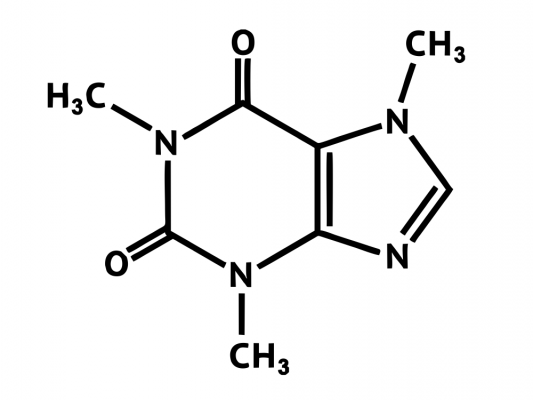Typical teas, coffees and sodas are known to contain a molecule familiar to most of us called caffeine. What is caffeine and what does it do?
Caffeine’s presence in common beverages makes it the most consumed drug in the world. The increased alertness, energy and mental awareness are effects felt in our brains after ingesting caffeine and are often cited as advantages. However, too much can cause problems with pregnancy, sugar control and blood pressure. The Food and Drug Administration caffeine guidelines currently recommend no more that 400 mg of caffeine intake daily through beverages. There are several variables such as brewing time, but in general that works out to be no more than two to three typical cups of coffee. About an ounce of dark chocolate provides nearly the same amount of caffeine as a shot of espresso. Caffeine can also be found added to some medicines. The isolated, white crystals of pure caffeine should never be directly consumed. Caffeine should not be used to replace positive effects of restful sleep.
So, where do we get caffeine? The molecule can be found in over 50 plants. Plants make it to ward off insect attacks. Caffeine found naturally in coffee and tea is maintained in the brewing process unless it specifically removed in another de-caffeinating process. Carbonated soft-drinks and energy drinks contain varying amounts of artificially added caffeine based on the manufacturer’s goals. Cocoa and Guarana seed, kola nut and yerba matte are also natural sources of caffeine.
We have a naturally occurring molecule called adenosine that when it is accepted at the specific receptors of the nerve cell (like cars getting their reserved spots in the parking lot) the nerve cells give their normal response of slowing down, and eventually this helps us slow things down for sleep. Now, back to parking. If cars that do not have permission park in reserved spots do so anyway, they prevent the cars with reserved spots from parking and the normal parking system no longer works as intended. A nerve cell no longer works the way it was intended either when caffeine takes adenosine’s reserved spot. The molecule structure of Caffeine molecules look a lot like adenosine molecules. So, what caffeine molecules can do is get into those reserved receptor adenosine spots effectively keeping neurons from working in their normal way. Not only do the caffeine molecules keep adenosine from their reserved sites, caffeine actually signals the nerve cells to speed up. That’s how caffeine gives us those effects of feeling energized.
Additionally, attached adenosine molecules expand blood vessels. With caffeine attached in place of adenosine, blood vessels begin to constrict. Other brain functions also begin to be affected when caffeine molecules replace adenosine.
The effects of caffeine on nerve cells can begin to be felt within just a few minutes after that first sip. However, it takes a few hours for your body to break down the caffeine (that’s why a cup of coffee before bed can interrupt sleep.)
Interested in more information about caffeine? There are numerous reports available on the internet that describe benefits and risks associated with this molecule. Like me, you are likely one of the 90% of Americans consuming caffeine every day, including today. Become aware of the effects, read beverage labels.
You can contact me via an email to: Mondaysmolecule@gmail.com for other caffeine related questions. You can also suggest other interesting molecules to feature on the program. Stay tuned for more Monday Molecule broadcasts. Right now I think it is time for coffee break…decaf?
